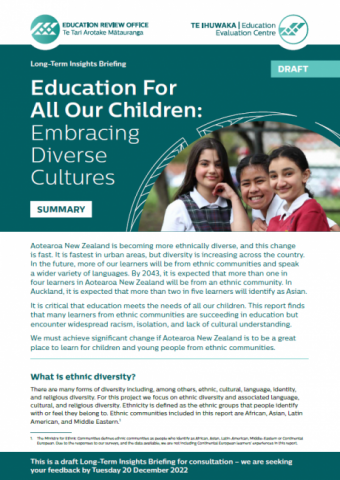Summary
Aotearoa New Zealand is becoming more ethnically diverse, and this change is fast. It is fastest in urban areas, but diversity is increasing across the country. In the future, more of our learners will be from ethnic communities and speak a wider variety of languages. By 2043, it is expected more than one in four learners in Aotearoa New Zealand will be from an ethnic community. In Auckland, it is expected that more than two in five learners will identify as Asian.
It is critical that education meets the needs of all our children, including learners from ethnic communities. This report finds that many learners from ethnic communities are succeeding in education but encounter widespread racism, isolation, and lack of cultural understanding.
We must achieve significant change if Aotearoa New Zealand is to be a great place to learn for children and young people from ethnic communities.
This is a draft for consultation – we are seeking your feedback
- You can make a submission through the following link: https://www.surveymonkey.com/r/DraftLTIBSubmission
- Questions are available in the following languages: English, Arabic, Chinese (Simplified), Hindi, Japanese, Khmer, Korean, Spanish, Tagalog, Vietnamese
- You do not have to answer all questions.
The closing date for submissions is Tuesday 20 December 2022.
Translated versions of this summary:
Arabic: التعليم لجميع أطفالنا: احتضان الثقافا تالمتنوعة | Education Review Office (ero.govt.nz)
Japanese: あらゆる子どもたちのためになる教育:多様な文化背景の尊重 | Education Review Office (ero.govt.nz)
Khmer: ការអ្ប់រំន ើមបីក្ូ នៅនយើងទុំងអ្េ់រន ៖ ទទួលយក្វបបធម៌ចព្រមរេះ | Education Review Office (ero.govt.nz)
Korean: 모든 어린이를 위한 교육: 다양한 문화의 포용 | Education Review Office (ero.govt.nz)
Simplified Chinese: 让教育面向我们所有的儿童: 拥抱多元文化 | Education Review Office (ero.govt.nz)
Whole article:
Education For All Our Children: Embracing Diverse Cultures - Summary of draft for consultationWhat is ethnic diversity?
There are many forms of diversity including, among others, ethnic, cultural, language, identity, and religious diversity. For this project we focus on ethnic diversity and associated language, cultural and religious diversity. Ethnicity is defined as the ethnic groups that people identify with or feel they belong to. Ethnic communities included in this report are African, Asian, Latin‑American, and Middle‑Eastern.[1]
What does ethnic diversity look like in Aotearoa New Zealand schools, and how is this likely to change?
Aotearoa New Zealand is becoming more ethnically diverse, and this is changing quickly.
It is fastest in urban areas, but diversity is increasing across the country. Learners will be from a wider range of ethnic communities. By 2043, it is expected just over one in four (26 percent) learners will identify as Asian and around one in 20 (3.6 percent) will identify as Middle Eastern, Latin American, or African (MELAA). In Auckland more than two in five (43 percent) learners will identify as Asian.
Figure 1: Proportion of learners in Aotearoa New Zealand who identify as Asian or MELAA
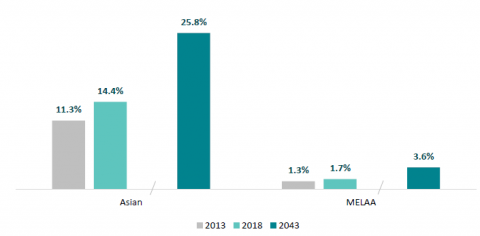
Figure 1: Proportion of learners in Aotearoa New Zealand who identify as Asian or MELAA
Source: Stats NZ
Figure 2: Proportion of learners who identify as Asian by 2043 for Auckland and Southland
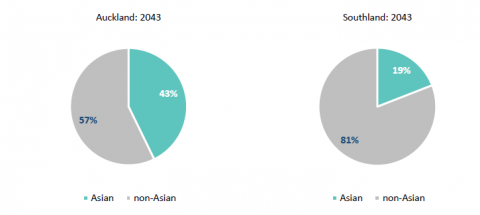
Figure 2: Proportion of learners who identify as Asian by 2043 for Auckland and Southland
Source: Stats NZ
What are the educational experiences of learners from diverse ethnic communities and their whānau?
Many, but not all, learners from ethnic communities achieve well in education.
Looking at NCEA Level 2 results, Filipino, Indian, Japanese, Vietnamese, and Korean learners all achieve above the national average. However, there are significant differences across ethnic communities, and within all ethnic communities there are learners who are not achieving well.
Figure 3: NCEA Level 2 attainment by Asian ethnicities (selected): 2021
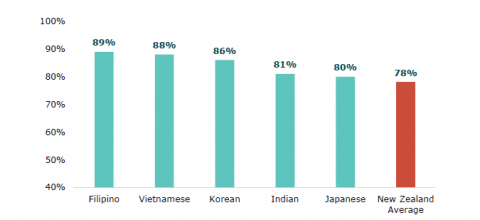
Figure 3: NCEA Level 2 attainment by Asian ethnicities (selected): 2021
Source: NZQA
Note: Year 12, enrolment based
Learners from ethnic communities often do not feel they belong.
Nearly one in five learners reported they frequently feel they do not belong and a third feel lonely at school. Nearly one in five also feel they have to hide their ethnic identity at school or feel excluded from activities because of their ethnic identity.
“I feel like the only time you can interact with your own culture is culture week.”
- Secondary school learner
Learners from ethnic communities experience widespread racist bullying, which too often is not taken seriously by their school.
One in five learners have experienced racist bullying in the last month, and over half have seen others being bullied because of their ethnicity. Both whānau and learners report racist bullying needs to be better identified and addressed at school.
Figure 4: Learners' experiences of bullying and racist messaging
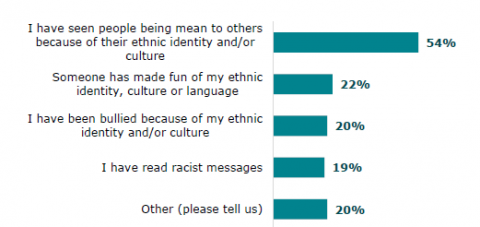
Figure 4: Learners' experiences of bullying and racist messaging
“I still feel kind of weird taking Indian food to school as you have to eat it with your hands. One of my friends—she is Indian too, got bullied so badly for her food (smelly) that she became a loner. And she tried to bring sandwiches to school even though she didn’t like the [taste], but it was too late.”
- Learner
Whānau from ethnic communities face barriers to engaging with schools.
They attend parent information sessions more than any other activity but find information about their children’s learning insufficient or confusing. They are significantly under-represented on School Boards.
Many learners from ethnic communities go on to tertiary study, but pathways are confusing and for some, choices are unfairly constrained by teachers’ biases.
More than one in four secondary learners report that teachers’ recommendations for their course selection are influenced by ethnicity, and only half of secondary learners are fully happy with their subject choices. Both learners and whānau find NCEA confusing.
“I still don’t know what I want to do when I leave here, and I think it gets more and more urgent each passing day because as I move on through the years, the options get narrower and narrower and I need to make a decision on a set pathway to go down - had an initial conversation about pathways in Year 9, but not really anything since.”
- Year 11 learner
How are schools meeting the needs of learners from diverse ethnic communities and their whānau?
Teachers’ understanding of their learners, including their culture, is key to learners’ experiences at school, but this needs building.
Whānau and learners are concerned about teachers’ lack of cultural knowledge and awareness. Teachers report having limited awareness of learners’ cultural and learning needs. More than half of teachers do not feel confident connecting with ethnic communities. Half of the learners from ethnic communities reported having their names mispronounced by their teacher.
What are the implications for education?
We have identified four big implications when considering the future of education in Aotearoa New Zealand.
- Every school needs to be able to respond to increased diversity. Ethnic diversity is increasing across the country – not just in Auckland – and the largest changes are in the school-aged population. This increase in ethnic diversity is reflected in an increase in the diversity of cultural values, and the diversity of languages spoken. Every school needs to be able to meet the needs of learners from ethnic communities.
- Every school will need to be able to tackle racism. In Aotearoa New Zealand there is more racism than we might think. Too many learners from ethnic communities experience racist bullying and racial biases. We must do better.
- We need to get better at delivering education for learners from ethnic communities. We need to understand more about what quality learning experiences and outcomes diverse ethnic communities want. This may include the types and locations of schools and subjects taught. We must increase the cultural capability of the current teaching workforce, and develop a more culturally diverse teaching workforce for the future.
- We need education to be good for learners and their whānau from ethnic communities to enable Aotearoa New Zealand to benefit from its increasing ethnic diversity. Learners and their whānau from ethnic communities have high aspirations for their learning and future pathways, and value maintaining their home languages. Supporting these aspirations and making Aotearoa New Zealand an attractive place to live for people of all ethnicities and cultures will help us strengthen our education system, workforce, culture, and relationships with other countries.
What are the implications for the future?
Many learners from ethnic communities are achieving in education but they have to overcome widespread racism, isolation, and lack of cultural understanding. We need to change. We will need action in five areas to ensure Aotearoa New Zealand is well-placed for the future.
- Strengthen understanding of diverse ethnic populations and what they want from education. Ethnic communities have a wide variety of perspectives, values, and priorities for education. We need to strengthen our understanding of these within the education context.
- Develop our thinking on how we meet the needs of learners from ethnic communities in Aotearoa New Zealand. By deliberately exploring how we navigate differing religions and cultural values, and the intersection between ethnicity, language, culture and identity in Aotearoa New Zealand’s education system, we can more effectively plan for the future.
- Recognise racism, understand the impacts and tackle it more effectively. In some schools, teachers, learners and others continue to allow ignorance, unconscious bias and stereotyping to affect the way they engage with learners from ethnic communities and their whānau. This impacts on learners’ experiences of bullying, expectations of them, and options for their future study. Collectively, we need to end racism.
- Proactively build a teaching workforce that is better able to meet the needs of learners from diverse ethnic communities and their whānau. To ensure learners from ethnic communities have teachers that understand them and meet their learning needs, we need to transform the teaching workforce.
- Harness the opportunities made available by the increasing ethnic diversity in Aotearoa New Zealand. Increasing ethnic diversity brings with it a wide range of opportunities that could strengthen not only Aotearoa New Zealand’s education system but our culture and economy. We need to realise these opportunities.
These are not quick actions; they will require sustained effort over coming decades. But the cost of not acting will be immense not only for the one in four Asian and one in 20 MELAA young people from ethnic communities by 2043, but for New Zealand’s social cohesion, economy and future.
If you want more detail about this project, our report is available on our website:
What ERO did
|
To understand how good education is for learners from diverse ethnic communities we gathered information in multiple ways: |
|
|
We appreciate the work of all those who supported this research, particularly the learners, parents and whānau from diverse ethnic communities; community leaders; and teachers and leaders from schools who shared with us. Their experiences and insights are at the heart of what we have learnt. |
[1] The Ministry for Ethnic Communities defines ethnic communities as people who identify as African, Asian, Latin-American, Middle-Eastern or Continental European. Due to the responses to our surveys, and the data available, we are not including Continental European learners’ experiences in this report.
